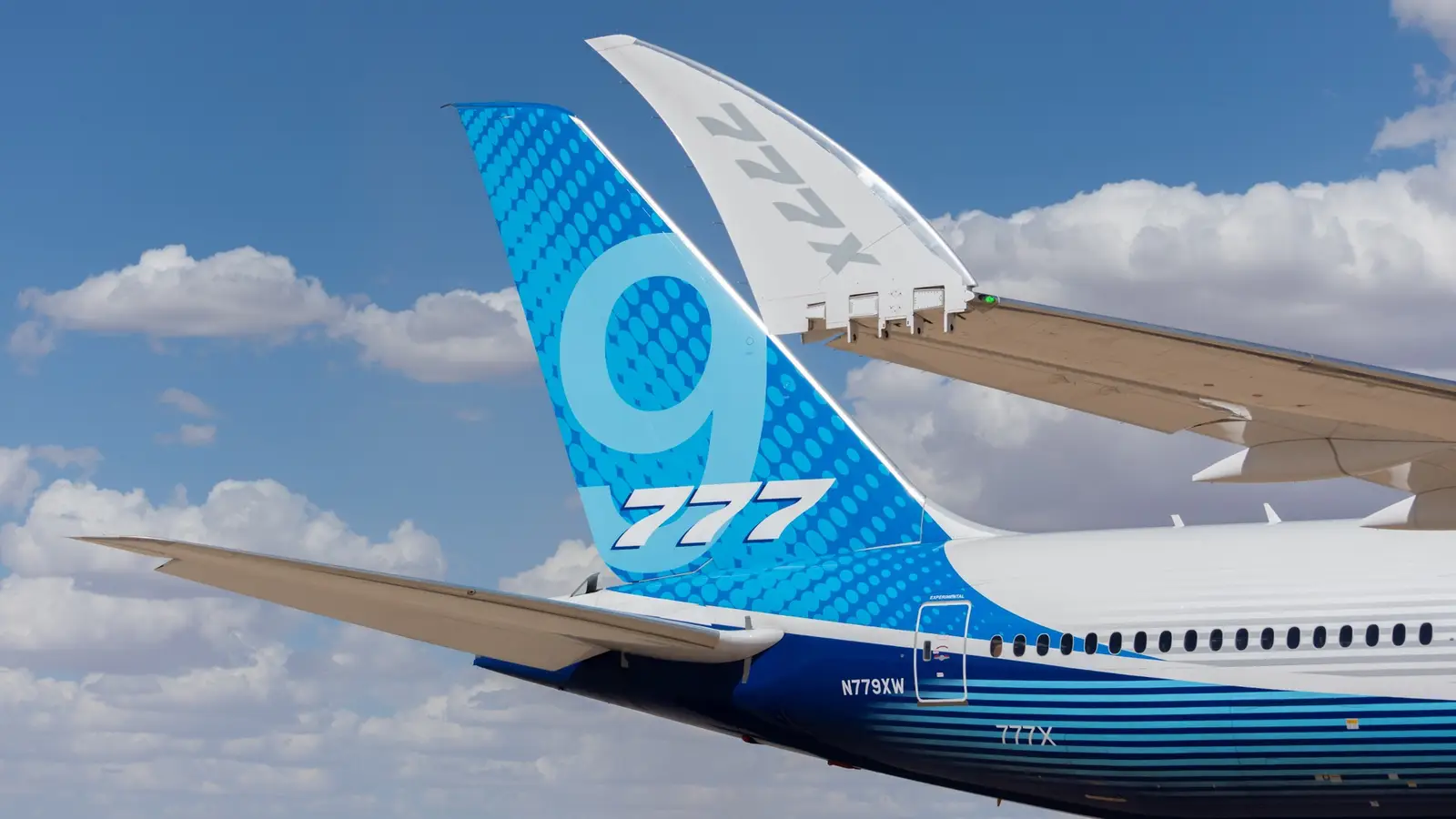
The Boeing 777X is the latest-generation widebody to be brought to the market by US-based manufacturer Boeing (NYSE: BA). The aircraft is designed to replace the Boeing 777-300ER and capture very long-haul missions with lower fuel burn and higher seating density. The aircraft comes in two variants: the high-capacity Boeing 777-9, geared towards trunk routes, and the ultra-long-range Boeing 777-8, geared towards the ultra-long-range segment. The aircraft features new carbon-fiber composite wings and folding wingtips, which extend the aircraft’s range and cruise efficiency. These wingtips also allow the aircraft to comfortably fit into Code-E gates. The jet’s GE9X engines will be the largest ever to enter commercial service with a passenger airline.
The aircraft’s cabin borrows a number of features from the earlier Boeing 787, including larger windows, improved pressurization and humidity, and wide cabins that support competitive business class layouts. The Boeing 777-9 seats between 380 and 420 passengers in a three-class configuration with a range of around 7,200 to 7,300 nautical miles. The Boeing 777-8 targets around 350 seats over an 8,700 nautical mile range, making it more ideal for thinner, ultra-long-range sectors. Current major customers for the model include Emirates, Qatar Airways, Lufthansa, British Airways, Cathay Pacific, ANA, Etihad, and Singapore Airlines.
A Breakthrough In Gate-Fitting Technology
The Boeing 777X’s folding wingtips allow Boeing to offer a high-aspect-ratio composite wing, which provides exceptional efficiency while in cruise control. However, the manufacturer still wants operators to be able to park the aircraft at Code-E gates when the tips fold on the ground. This single design choice drastically changes airport math. Carriers chase long-haul route economics without triggering costly aircraft stands or requiring widened taxiways. From an operational perspective, this leverages advanced technology to provide flexibility for operators unlike anything ever seen before.
This is exceptionally valuable for operators that fly in and out of slot-constrained hub facilities. Some airports, like London Heathrow Airport (LHR), are pretty much already operating at maximum capacity, with little room for additional flights. As a result, airlines are in a position where they are required to purchase landing slots in order to gain access to the airport, and some of these slots can go for millions of dollars. At these kinds of slot-constrained hubs, the Boeing 777-9 can deliver Boeing 777-300ER-level capacity and range using existing airport infrastructure.
For airports, this is a hedge. The aircraft ensures that it can expand capacity without having to invest in the expensive development of wider gates that can accommodate its exceptional wingspan. Over time, this gate-fit innovation will gradually become a template for others to follow, as continuing to modify airports to fit larger and wider aircraft is both expensive and inefficient. Expanding some gates means eliminating others, something very unpopular at airports that continue to become increasingly crowded each year.
A New Frontier In Long-Haul Unit Costs
The Boeing 777X pushes down long-haul costs per seat while preserving the Boeing 777’s belly cargo space and maintaining the same amount of premium cabin real estate. This ensures that the aircraft can offer an efficient gauge on sectors that have flight times between 8 and 14 hours. On trunk routes, the aircraft can consolidate off-peak demand into a single departure with more seats, offering better per-seat economics and a stronger premium density, something valuable to today’s hub carriers that operate out of slot-constrained hubs.
On thinner, long sectors, the Boeing 777-8’s payload-range profile supports city pairs that push the Boeing 787-10 to its limits, but don’t require the hefty gauge of an Airbus A380. This enabled new on-stop-to-nonstop upgrades and robust winter schedules. The aircraft’s geometry also shifts for alliances, with more seats at competitive unit costs allowing the airline to sustain corporate contracts without adding frequencies that erode aircraft yields. In leisure-heavy markets, lower per-seat-mile costs improve off-season viability, allowing airlines to use the jet to stabilize off-season connectivity.
The aircraft’s floor plan also caters to premium-friendly operations, with wide aisles and big galleys. Business class suites with closing doors, true premium economy depth, and a healthy economy cabin are all options, allowing airlines to balance yield mix and scale as desired. The net effect of this aircraft entering service will be a valuable fleet tool that widens the profitability envelope for airlines on all kinds of high-density routes.
A Quieter, Calmer Long-Haul: Cabin And Comfort Upgrades
Borrowing from the Boeing 787’s cabin design, the Boeing 777X offers improved pressurization and humidity, ensuring that passengers can relax in a quieter environment with a wider fuselage cross-section. This supports roomier aisles and more generous shoulder space for passengers. The aircraft is a canvas on which airlines can install next-generation business class suites, most of which feature doors, in addition to large premium economy seats with layouts that allow credible seat width. This reduces anticipated passenger fatigue on 10 and 15-hour segments.
More aerodynamically clean wings and modern flight control systems reduce turbulence during flights, resulting in improved sleep quality for passengers. Cabins are also insulated to reduce overall noise, and LED lighting is reduced to improve circadian rhythms. Improved airflow control reduces perceived jet lag and enhances meal pacing without leading to clogs in galleys.
For passengers who are interested in remaining fully connected while on the go with abundant power and reliable Bluetooth audio, the experience can feel less like an endurance test and more like a productive work block or restful overnight travel. The Boeing 777X offers this comfort at scale, with hundreds of seats per flight. This combination of quiet operations and a comfortable environment will set a new standard for long-haul comfort, pushing operators to match this new exceedingly high bar in order to ensure the most comfortable experience possible for their passengers.
Fuel Burn And A Path To Lower Carbon Emissions
The Boeing 777X’s efficiency story involves blending carbon-fiber wings and advanced aerodynamics with GE9X engines that use ceramic-matrix composites and lean-burn combustors. This ensures that a very high bypass ratio is utilized as it will reduce fuel consumption. For airlines, this offers lower trip costs and lower fuel burn per seat, something which is compounded by carbon pricing and sustainable aviation fuel (SAF) blending mandates, which continue to rise. Overall, community noise footprints continue to shrink, easing night-bank operations and slot negotiations at major hubs.
Aircraft compatibility with high-blend sustainable aviation fuel helps airlines decarbonize quicker, with aircraft efficiency preserving range and payload when SAF energy density or supply drives contract margins. Fewer flights can carry the same number of passengers due to the aircraft’s higher gauge, reducing overall movements and associated carbon emissions in the market. Here are some specifications from the Boeing 777-8 from manufacturer Boeing:
Beyond flight operation, commonality exists between the Boeing 777X and existing Boeing 777 maintenance networks, allowing the aircraft to easily integrate into the fleets of legacy Boeing 777 operators. With a fleet life measured in decades, these incremental fuel gains certainly compound, especially on the world’s highest-demand flagship sectors where marginal drag and increased engine efficiency matter the most. The outcome, in the end, is not a single silver bullet but a credible step down the emissions curve that scales at a global level.
Ripple Effects Across The Industry
Because the Boeing 777X is an update of the popular Boeing 777 family, airlines can use the same pilots, procedures, and maintenance setup that they already have in place. This makes it faster to put into service and less risky than a brand-new model.
Aircraft training is relatively simpler too, as crews can easily move between Boeing 777 versions in order to cover busy seasons or disruptions. This allows them to keep schedules steady and maintain costs in check. While on the ground, a large, modern Boeing 777 fleet supports spare parts suppliers and repair shops, lowering maintenance time frames across an entire fleet.
The Boeing 777X also accommodates a large amount of belly cargo without compromising passenger cabin space, making it ideal for e-commerce and pharmaceuticals on longer routes. Regulators will also set clear rules for folding wingtips and similar aircraft features, paving the way for more efficiency gains in the long run. Passengers can also get used to seeing this at airports.
So, What Is The Bottom Line When It Comes To The Boeing 777X?
At the end of the day, the Boeing 777X will fundamentally change the aviation industry when it enters service. The era of large-capacity widebody jets like the Airbus A380 and the Boeing 747 may be over.
However, the introduction of new, capable models with long-range capabilities that have the appealing operating economics of twin-engine aircraft will become more popular than ever. Jets like the Boeing 777X continue to be among the most innovative aircraft on the market and operators anxiously await their entry into service.
Ensuring that models like the Boeing 777X not only enter service cleanly but are able to have an extensive impact on the market will prove essential for operators. The jet will become a common sight at airports, and it will offer an exceptional passenger experience with unbeatable economics for airlines.



